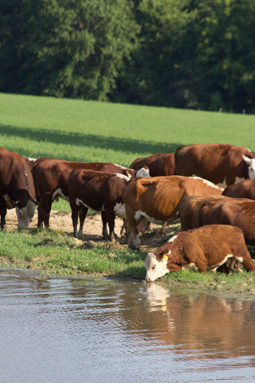The arrival of early rains could ease your worries about water supplies for the summer, but will you have enough good-quality water to get through the year? Early summer is the time to have your livestock water sources tested to be sure.
Water is the most important nutrient for livestock. Water is needed for all metabolic processes essential for life, growth and reproduction. The quantity of water animals consume is affected by many factors including growth, pregnancy, lactation, activity, diet composition, feed intake and environmental temperature. The quality of water offered can also affect consumption and performance.
Many producers rely on wells and surface waters such as ponds and streams to provide water for livestock, but these sources can be contaminated by many pollutants within the watershed. Nitrates, bacteria, organic material and suspended solids are common sources of pollution. Additional factors that affect water quality and consumption are salinity, sulfates and mineral concentrations.
If cattle are allowed to stand in water sources, fecal and urine contamination will decrease water quality and can spread diseases.
In addition, allowing cattle unlimited access to ponds will usually result in suspension of sediments that can decrease water quality and consumption. Fencing off ponds to provide limited access points or gravity-fed water troughs can decrease fecal contamination and prevent cattle from stirring up sediments.
Wells should be protected from contaminants by sealing around the wellhead with a concrete pad and locating the well at least 150 to 300 feet from livestock working facilities, lagoons, septic tanks and manure stockpiles.
In addition, pasture management can greatly impact water quality. Poor forage stands within a watershed can contribute to erosion and nutrient transport, resulting in decreased water quality.
Careful consideration should be taken when applying fertilizers, manure, herbicides and pesticides.
Testing your livestock water sources is the only way to know if they are acceptable for livestock use. All water sources should be tested annually at the beginning of the summer to identify potential problems and to assess the quality of each source. If a water source is tested and determined to be marginal, a management plan should be developed to utilize the forages associated with these sources before the water becomes health-threatening and performance-threatening.
In addition, you can be prepared for potential water quality problems that can easily arise throughout hot, dry periods due to evaporation and use. As always, the sooner problems are identified, the easier they are to manage, even if this means you have to provide a new water source.
Questionable water sources, including ponds that have decreased in size, sources that may have been contaminated and any that were marginal at the beginning of the summer, should be tested again as supplies become limited. Periods of hot, dry weather can concentrate dissolved contaminants through evaporation, leaving water that may be unacceptable for livestock use.
Livestock should be provided with free-choice access to clean, quality water at all times.
Water quality is often overlooked, even though research is clear that growth and reproductive performance is decreased when certain components of water quality reach threshold levels.Poor water quality also affects consumption, which may limit feed intake and animal health.
Contact a livestock consultant at the Noble Foundation or your local extension agent for additional information about livestock water testing.












